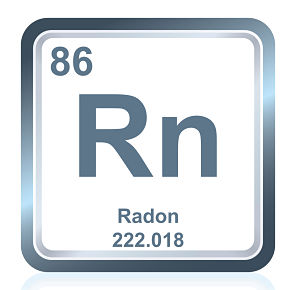
The element Radon on the periodic table. 86 Rn Radon 222.018
DO YOU KNOW YOUR RADON NUMBER?
According to the Centers for Disease Control and Prevention, radon is the number one cause of lung cancer for non-smokers, and the second leading cause of lung cancer overall.
Radon is an odorless, tasteless, colorless, naturally-occurring radioactive gas that comes from the soil underneath our homes. Outdoors it's not a concern - but indoors it can build up, increasing your exposure to radiation, which increases your risk for developing lung cancer. You only have to worry about radon in your home if your pCi/L (the system used to measure the radon) is 4 or higher. This happens in very few homes but is still possible.
Testing for radon is easy. For the most accurate results, the test must be conducted in the right place within the home. Test kits can be purchased through many local and state agencies for a nominal charge.
The best place to test is on the lowest, lived-in level. A basement with a family room or bedroom is a good place to test. If your basement is totally storage, then you probably want to test on the first floor, in a bedroom, living room, or family room.
The tests typically include a prepaid mailing envelope for returning the test to a lab for processing. The lab will send results by mail and will post the results online, according to the serial number on your test kit.
For any initial test resulting in a reading of 4 or higher, a longer follow-up test is recommended. If that test confirms the presence of elevated radon levels, special equipment can be installed to lower radon levels within your home.
The typical radon mitigation system involves a permanently-installed venting pipe and fan. The radon will be drawn or sucked from beneath the house with a small, continuously running fan. It is vented into the air above the home, where it will dissipate.
A standard radon reduction system will cost about $1500. The contractor will install the kit according to the standards. Installation usually takes a day, is often effective within 24 hours and you can live in comfort and safety. The important thing is getting a guarantee of a radon level of below 4 from the contractor that installs it.
If you have trouble finding a qualified contractor to install your system, contact your State Radon Program to see if they have a list of certified individuals that can help you out. The National Radon Proficiency Program and the National Radon Safety Board both have websites where you can search for contractors in your state or area.
While $1,500 may sound high, when compared to the potential costs of fighting lung cancer, it's a bargain. The cost of diagnosing and treating lung cancer is so much more.
Every home has radon, although the majority of them have very small levels. It is important that you test your home, fix if necessary, and save a life. There is no cure for radon poisoning and prolonged exposure can lead to developing lung cancer. If you have been exposed to radon, contact your local physician or Sabetha Family Practice for more information.
